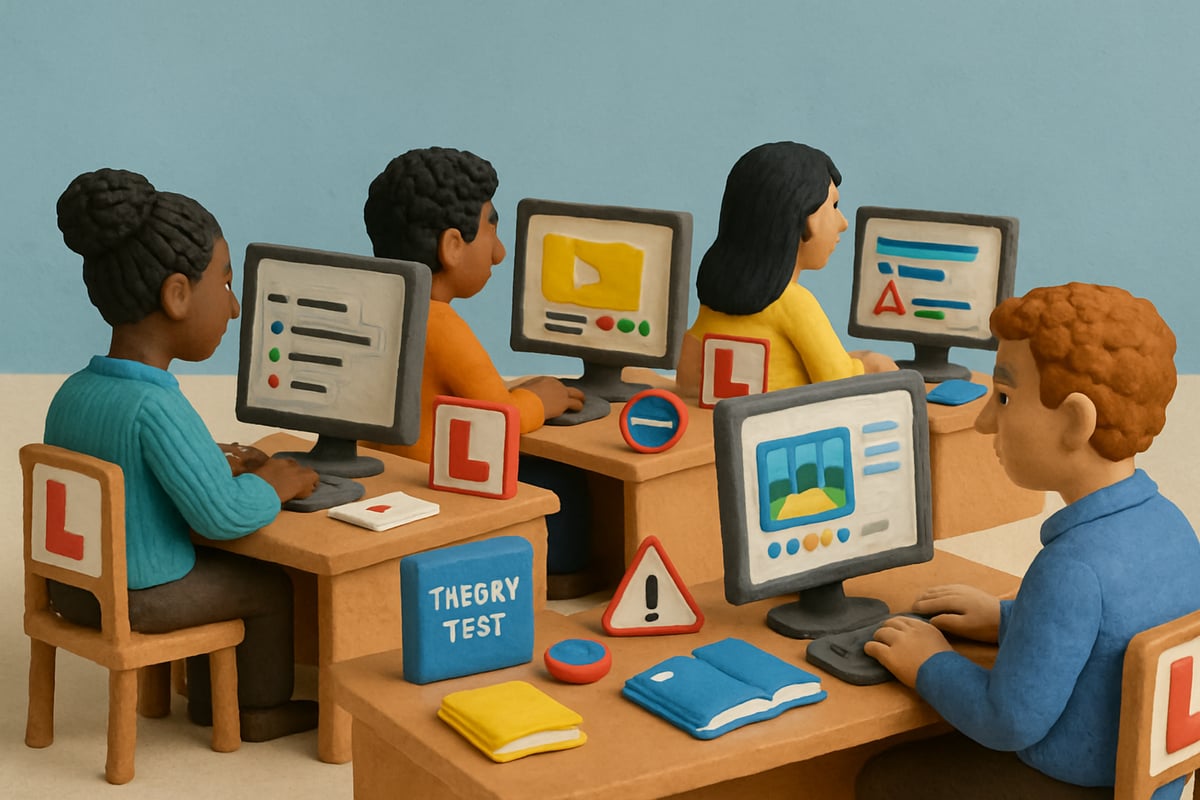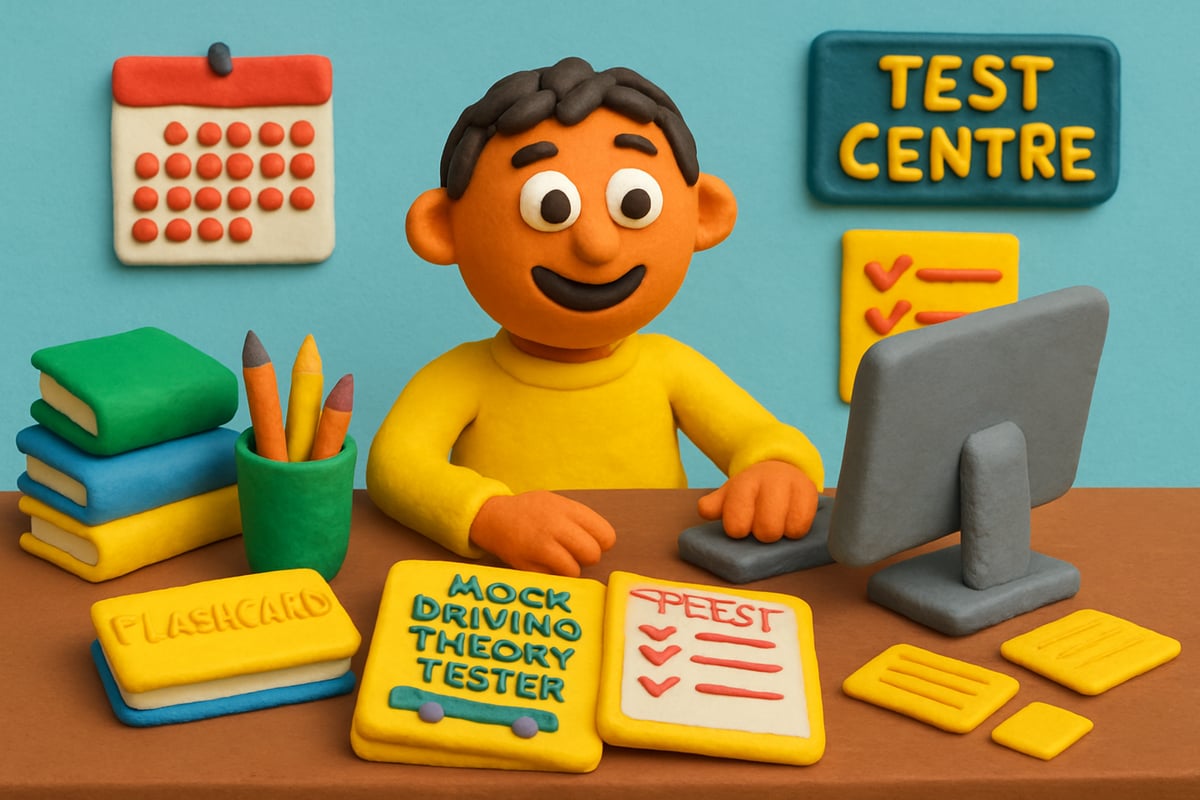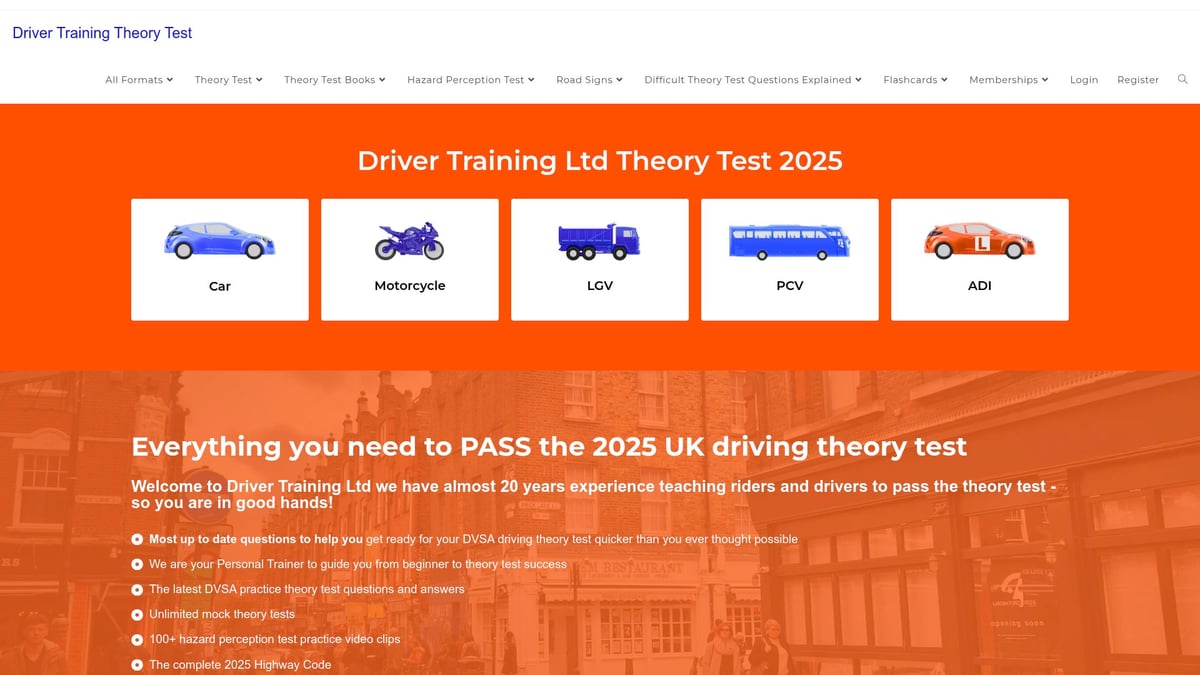The driving theory tester is becoming more vital than ever for anyone starting their driving journey in 2025. With pass rates shifting and the DVSA updating regulations, new learners face a more challenging environment than previous years.
Recent changes introduce not only tougher question formats but also a more complex test structure. This makes early preparation essential for every candidate. Mastering the theory test is your first step to safe, confident driving and securing a full licence.
This guide will help you understand the 2025 test structure, offer step-by-step preparation strategies, provide essential study tips, share top resources, and highlight common mistakes to avoid.
Understanding the 2025 Driving Theory Test
The 2025 driving theory tester is more important than ever for UK learners. Updated rules, new question types, and a focus on real-world safety mean that understanding the test is key for success. This section breaks down what to expect, essential topics, pass rates, and why early preparation matters.
What is the Driving Theory Test?
The driving theory tester is a standardized assessment created by the DVSA to ensure all road users understand the rules, responsibilities, and hazards of UK driving. Unlike the practical test, which measures hands-on driving ability, the theory test checks your knowledge of laws and safe practices.
Anyone seeking a car, motorcycle, LGV, PCV, or ADI licence must pass the driving theory tester before booking their practical exam. In 2025, the DVSA has updated the test with new question formats, more scenario-based items, and a revised scoring system. For a detailed overview of the test’s requirements and structure, see the Driving theory test explained.
Structure and Components of the 2025 Test
The 2025 driving theory tester consists of two main parts:
- Multiple-choice section: 50 questions, 57 minutes, pass mark of 43/50.
- Hazard perception: 14 video clips, up to 5 points per clip, pass mark of 44/75.
New for 2025, you’ll see interactive question types and more complex hazard scenarios. Both digital (online) and in-person test options are available, giving candidates flexibility. The driving theory tester now challenges you with real-life situations, not just rote memorization.
Key Topics Covered in the Test
The driving theory tester covers a broad range of essential topics:
- Highway Code rules and updates
- Road signs and markings
- Attitude, alertness, and hazard awareness
- Motorway and eco-driving principles
- Vulnerable road users
For example, you may see questions like: “What does a red triangle road sign indicate?” or “How should you respond to a developing hazard on a dual carriageway?” The 2025 driving theory tester introduces more questions on environmental awareness and the safe sharing of roads.
Recent Pass Rates and What They Mean for Beginners
Recent DVSA data shows the average pass rate for the driving theory tester in 2023–2024 was around 47%. Many candidates fail due to insufficient preparation or underestimating scenario-based questions.
Common reasons for failing the driving theory tester include missing hazard cues, struggling with new question formats, and gaps in Highway Code knowledge. As the test becomes more challenging, success demands a deeper understanding, not just surface learning.
Importance of Early and Thorough Preparation
Last-minute cramming rarely leads to a pass on the driving theory tester. Candidates who start early, using spaced repetition and regular practice, have significantly higher pass rates.
On average, successful learners spend 20–30 hours preparing for the driving theory tester. Building strong theory knowledge directly supports safer, more confident practical driving. Early mastery of the driving theory tester lays the foundation for lifelong safe driving.
Step-by-Step Preparation for the Theory Test
Preparing for the 2025 driving theory tester requires a strategic approach. With updated regulations and evolving question formats, beginners must follow a structured path to maximize their chances of passing. This section guides you through each critical step, ensuring you're well-equipped from registration to test day.
Step 1: Registering and Booking Your Test
The journey to becoming a licensed driver begins with registering for your driving theory tester. Ensure you meet eligibility requirements: you must be at least 17 years old (16 for mopeds) and hold a valid UK provisional licence.
Booking is straightforward. Visit the official DVSA portal, where you can select your preferred test centre from a comprehensive list covering all regions in 2025. Choose a date and time that fits your schedule.
Test fees are paid online using debit or credit cards. Keep your confirmation email and prepare your ID for test day. Early booking is wise, as popular centres fill up quickly.
Step 2: Gathering Official Study Materials
Success with the driving theory tester depends on using accurate, up-to-date resources. Start with the 2025 Highway Code—available in bookstores, online, or as a DVSA app. Official DVSA theory test books and mobile apps are essential for staying current.
Compare materials to find what suits your learning style:
| Material Type | Pros | Cons |
|---|---|---|
| Official DVSA App | Interactive, always up-to-date | Requires smartphone |
| Printed Book | Great for highlighting, offline access | Can be outdated quickly |
| Online Platforms | Unlimited practice, instant feedback | May require subscription |
Review both free and paid resources to ensure comprehensive coverage.
Step 3: Creating a Personalized Study Plan
A tailored study plan is vital for mastering the driving theory tester. Begin by outlining your available time and setting realistic goals. Break the syllabus into manageable sections—such as road signs, hazard awareness, and eco-driving.
Use digital calendars or apps to schedule daily or weekly study sessions. Set reminders to keep on track.
Here’s a sample 4-week schedule:
- Week 1: Highway Code basics, road signs
- Week 2: Attitude, alertness, and hazard awareness
- Week 3: Motorway rules, eco-driving, vulnerable road users
- Week 4: Review and full-length mock tests
Personalization ensures you focus on weak areas and avoid last-minute cramming.
Step 4: Practicing with Mock Tests and Hazard Perception Clips
Practice is the cornerstone of success for any driving theory tester candidate. Regular mock tests simulate real exam conditions, helping you manage time and reduce anxiety.
Access unlimited practice questions and hazard perception clips to identify knowledge gaps. Analyze incorrect answers for targeted revision.
For hazard perception, use interactive resources such as Hazard perception practice tests to experience a variety of realistic scenarios. Consistent practice leads to measurable improvement, with many learners increasing their scores by 20% after several mock sessions.
Step 5: Reviewing Mistakes and Reinforcing Knowledge
Mistake analysis is a proven way to boost your driving theory tester performance. Keep a dedicated log of questions you get wrong. Review explanations to understand the logic behind correct answers.
Use flashcards and quick quizzes to reinforce knowledge. Peer discussions in online forums can clarify tricky concepts and boost motivation.
Group study sessions also offer diverse perspectives, making complex topics easier to grasp. Regular review transforms weaknesses into strengths.
Step 6: Test Day Preparation and What to Expect
Final preparations ensure confidence on the day of your driving theory tester. Pack your provisional licence, booking confirmation, and any required identification.
Arrive at the test centre early to allow time for security checks and computer setup. Here’s a quick checklist:
- Provisional licence and ID
- Confirmation email or letter
- Arrive 15 minutes early
- Leave personal items in lockers
During the test, stay calm and manage your time wisely. Most candidates find the environment supportive, with clear instructions and helpful staff. A positive mindset makes a measurable difference.
Top Study Strategies and Tips for Beginners
Preparing for the driving theory tester in 2025 requires more than just reading a handbook. Success comes from using proven study methods, practicing consistently, and making the most of digital and peer resources. Let’s explore the top strategies to help you build confidence and maximise your chances of a first-time pass.
Active Learning Techniques That Work
Passive reading rarely leads to success on the driving theory tester. Instead, embrace active learning by using spaced repetition and regular recall exercises. Flashcards and summary sheets can help reinforce tricky information and improve memory retention.
Try creating your own flashcards for rules, signs, and common hazards. Practice with quick quizzes, and review explanations for any mistakes. For more help with challenging questions, check out Difficult theory test questions to avoid common pitfalls.
Studies show that active recall boosts retention rates compared to simply reading notes. By focusing on repeated, targeted practice, you’ll build a stronger foundation for the driving theory tester.
Maximizing Hazard Perception Skills
A major part of the driving theory tester is hazard perception. Understanding developing, potential, and immediate hazards is essential. Watch a variety of real-life and CGI clips to spot subtle dangers, such as parked vehicles obstructing views or cyclists approaching junctions.
Break down each clip after watching—ask yourself, what was the first sign of a hazard? Which cues did you miss? Use this self-reflection to sharpen your skills. Remember, the scoring system rewards early detection, so practice reacting promptly.
Many beginners miss common hazards like pedestrian crossings or emerging side roads. Consistent practice will build your confidence and accuracy in this vital section of the driving theory tester.
Leveraging Digital Resources and Apps
Modern learners benefit from a range of digital tools tailored for the driving theory tester. Highly-rated apps offer interactive quizzes, video explanations, and detailed progress tracking. These resources adapt to your strengths and weaknesses, providing a personalised study path.
Here’s a quick comparison of app features:
| Feature | Benefit |
|---|---|
| Mock tests | Simulate real test conditions |
| Video explanations | Clarify complex topics |
| Progress tracking | Monitor improvement |
| Flashcards | Aid quick revision |
While mobile study is convenient, balance it with offline revision to avoid distractions. Many top scorers combine app usage with traditional study for the best results on the driving theory tester.
Group Study and Peer Support
Studying for the driving theory tester doesn’t have to be a solo journey. Learning with friends or joining online communities can provide motivation, shared resources, and a sense of accountability. Discussing tricky questions or road scenarios helps deepen understanding.
Participate in Q&A forums or set up virtual group sessions to quiz each other. Share useful study materials and celebrate milestones together. Real-world examples show that group study often leads to higher pass rates and a more enjoyable experience with the driving theory tester.
If you prefer in-person support, consider local workshops or study groups offered by driving schools. Peer encouragement can make a significant difference.
Managing Study Time and Motivation
Time management is crucial when preparing for the driving theory tester. Set up a distraction-free study space and use calendars or reminders to schedule regular sessions. Break your study into short, focused blocks to maintain concentration and avoid burnout.
Reward yourself after meeting goals, and try gamifying your progress with points or small prizes. When motivation dips, revisit your reasons for learning—safe driving, independence, and passing the driving theory tester.
Top scorers often credit consistency and a positive mindset for their success. Find what motivates you, and stick to your routine for the best results.
Essential Resources for 2025 Theory Test Success
Preparing for the 2025 driving theory tester requires the right set of resources. With updated DVSA content, new question types, and evolving exam standards, knowing where to find trusted materials can make a significant difference. Below, you’ll find a breakdown of the most effective tools and platforms to power your study journey.
Official DVSA Materials and Where to Find Them
The DVSA remains the gold standard for driving theory tester preparation. Their official books, interactive apps, and online practice tests are updated annually to reflect the latest rules and question formats. Always confirm you’re using the 2025 edition to avoid outdated content.
Official DVSA Resources Table
| Resource Type | Where to Find | Key Benefit |
|---|---|---|
| Highway Code Book | Bookshops, DVSA website | Authoritative rulebook |
| Theory Test App | App stores, DVSA site | Realistic practice, tracking |
| Online Mock Tests | DVSA site | Up-to-date question pool |
Using these resources ensures every driving theory tester candidate gets reliable, DVSA-approved information.
Comprehensive Online Learning Platforms
Modern driving theory tester platforms offer much more than just practice questions. Look for options with unlimited mock tests, extensive hazard perception libraries, and adaptive learning technology. Top-rated platforms also include user progress analytics, video tutorials, and forums for peer interaction.
When comparing platforms, check for mobile compatibility, regular content updates, and positive user testimonials. Many learners benefit from interactive features that mimic the real test environment, building confidence and familiarity. Choosing a comprehensive platform can streamline your preparation and improve your chances of a first-time pass.
Driver Training Ltd: Your Personal Trainer for Theory Test Success
Driver Training Ltd stands out as a leading driving theory tester resource for 2025. The platform offers up-to-date DVSA questions, unlimited mock tests, and over 100 hazard perception clips. Members benefit from tailored learning paths, expert video tutorials, and flexible online access.
Key Features:
- Personal trainer approach for individual support
- Flashcards and revision notes for fast recall
- Coverage for all vehicle categories, including cars, motorcycles, LGV, and PCV
- Nearly 20 years of proven results helping learners succeed
Driver Training Ltd’s blend of free and premium resources empowers every driving theory tester to prepare with confidence.
Free and Low-Cost Practice Resources
Budget-friendly resources can supplement your main study plan. Sample questions and downloadable guides are widely available, and free hazard perception clips help you target weak spots. Using a combination of official and free materials is proven to boost pass rates.
For extra practice, try Could you pass the 2025 driving theory test?, which offers sample questions matching the new test format. Mixing these with official content ensures a well-rounded driving theory tester preparation routine.
In-Person and Instructor-Led Support
Some learners thrive with hands-on guidance. Local driving schools and theory test workshops provide structured lessons, group discussions, and instant feedback. Instructor-led sessions can clarify complex topics and keep motivation high.
Success stories consistently show that blending personal tutoring with self-study resources leads to higher scores. For many, this balance is the secret to acing the driving theory tester and moving confidently to the practical exam.
Common Mistakes and How to Avoid Them
Preparing for the driving theory tester requires more than memorizing facts. Many candidates make avoidable mistakes that can impact their results. By understanding these pitfalls, you can improve your chances of passing the first time.
Underestimating the Test’s Difficulty
A common mistake with the driving theory tester is assuming it will be easy based on what friends or family say. Many candidates walk in overconfident and are surprised by the test's complexity and scenario-based questions. In 2023–2024, the pass rate hovered around 47%, reflecting the challenge.
Often, those who fail did not study the full range of topics or skipped sections they thought were "easy." Real-world examples show even experienced drivers struggle with new question formats. To avoid this, review expert advice and sample questions, such as those found in Understanding the UK Theory Test: Key Topics, Sample Questions, and Expert Advice for 2025, and commit to thorough preparation.
Ignoring Hazard Perception Practice
Another major pitfall with the driving theory tester is neglecting the hazard perception section. Statistics consistently show this is a leading cause of failure. Many candidates focus only on the multiple-choice questions and underestimate the importance of spotting developing hazards in time.
Hazard perception videos test your ability to react quickly and recognize potential dangers. Failing to practice means missing out on critical points. To succeed, integrate hazard clips into every study session, track your scores, and review which hazards you often miss. Regular practice builds confidence and improves your response time.
Cramming and Poor Time Management
Cramming the night before is rarely effective for the driving theory tester. Data shows that successful candidates typically dedicate 20–30 hours over several weeks, while those who fail often study last minute. Rushed preparation leads to stress, poor recall, and gaps in knowledge.
To avoid this, create a study schedule that breaks down topics into manageable chunks. Use tools like calendars and reminders to stay on track. Spreading your study sessions increases long-term retention and allows time to revisit difficult areas, making your preparation far more effective.
Overlooking the Latest Test Changes
Staying up to date is crucial for any driving theory tester candidate. The 2025 theory test brings new question formats and Highway Code updates. Using outdated materials risks missing vital content and misunderstanding new regulations.
To stay informed, always use the latest official resources and follow reputable updates. For a detailed overview of upcoming changes, consult the UK Driving Theory Test Rule Changes Coming September 2025. Regularly checking for updates ensures you are fully prepared for what you’ll encounter on test day.
Now that you understand what’s ahead on the 2025 driving theory test and how important thorough preparation truly is, why not take the next step and see where you stand? You deserve up-to-date practice that matches the real exam—right down to the latest DVSA questions and hazard perception clips. Give yourself the best possible start by exploring free, unlimited mock tests from a platform trusted by learners for nearly two decades. Let’s turn your preparation into confidence—Practice for free and see how far you can go.
Contents
- 1 Understanding the 2025 Driving Theory Test
- 2 Step-by-Step Preparation for the Theory Test
- 2.1 Step 1: Registering and Booking Your Test
- 2.2 Step 2: Gathering Official Study Materials
- 2.3 Step 3: Creating a Personalized Study Plan
- 2.4 Step 4: Practicing with Mock Tests and Hazard Perception Clips
- 2.5 Step 5: Reviewing Mistakes and Reinforcing Knowledge
- 2.6 Step 6: Test Day Preparation and What to Expect
- 3 Top Study Strategies and Tips for Beginners
- 4 Essential Resources for 2025 Theory Test Success
- 5 Common Mistakes and How to Avoid Them





